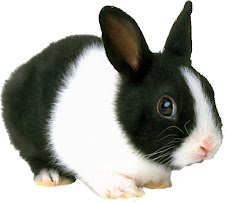Rabbits are herbivores who feed by grazing on grass, forbs and leafy weeds. In consequence, their diet contains large amounts of cellulose, which is hard to digest. Rabbits solve this problem by passing two distinct types of feces: hard droppings and soft black viscous pellets, the latter of which are immediately eaten. Rabbits reingest their own dropping(rather than chewing the cud as do cows and many other herbivores) to digest their food further and extract sufficient nutrients. between 8 o'clock in the morning and 5 o'clock in the evening, being carried out intermittently within that period.
Hard pellets are made up of hay-like fragments of plant cuticle and stalk, being the final waste product after redigestion of soft pellets. These are only released outside the burrow and are not reingested. Soft pellets are usually produced several hours after grazing, after the hard pellets have all been excreted. They are made up of micro-organisms and undigested plant cell walls.
The chewed plant material collects in the large cecum, a secondary chamber between the large and small intestine containing large quantities of symbiotic bacteria that help with the digestion of cellulose and also produce certain B vitamins. The pellets are about 56% bacteria by dry weight, largely accounting for the pellets being 24.4% protein on average. These pellets remain intact for up to six hours in the stomach; the bacteria within continue to digest the plant carbohydrates. The soft feces form here and contain up to five times the vitamins of hard feces.. After being excreted, they are eaten whole by the rabbit and redigested in a special part of the stomach. This double-digestion process enables rabbits to use nutrients that they may have missed during the first passage through the gut, and thus ensures that maximum nutrition is derived from the food they eat.[1] This process serves the same purpose within the rabbit as rumination does in cattle and sheep







sya punya 5 kelini usia 3 bulanan. mo tanya kenapa ya kelinci sya tidak mo makan rabbit food? sya kerepotan kalo harus beli sayur. trims LUNAR....
ReplyDeleteMbak Sisca, hal itu sebenarnya lumrah terjadi, terutama pada kelinci usia muda karena perbedaan jenis makanan di peternak dengan penghobi. Maka solusinya kelinci harus diadaptasikan terlebih. Tetap berikan makan hijau yang sudah dijemur agak kering dan dilumuri dengan pelet. Semakin lama porsi sayur dikurangi dan pelet ditambah hingga terbiasa... salam.
ReplyDelete